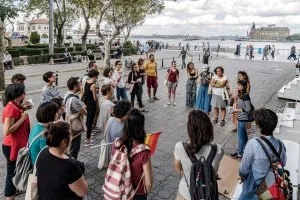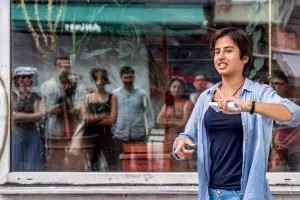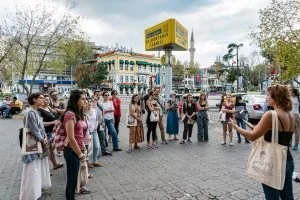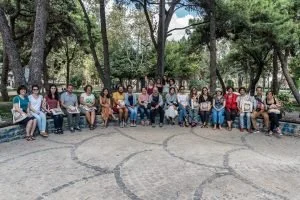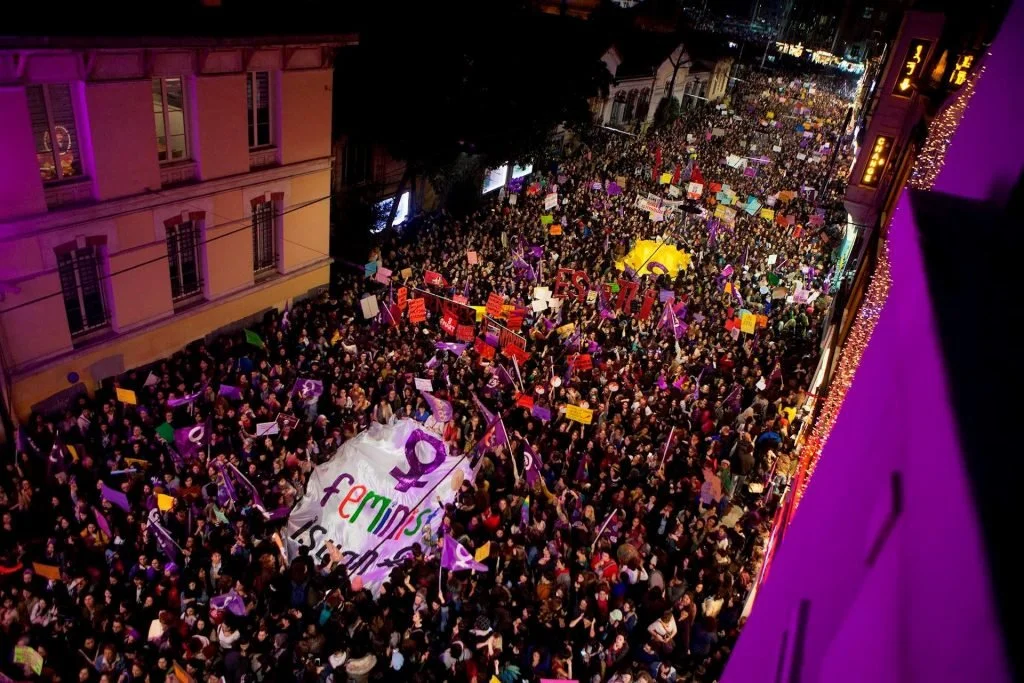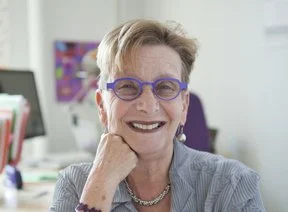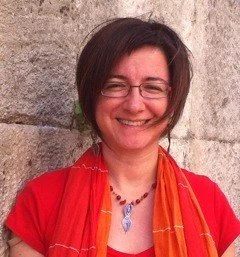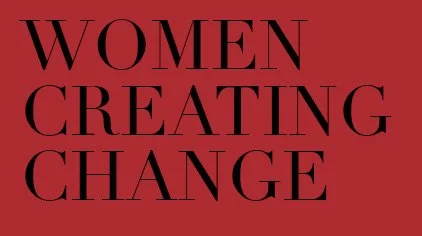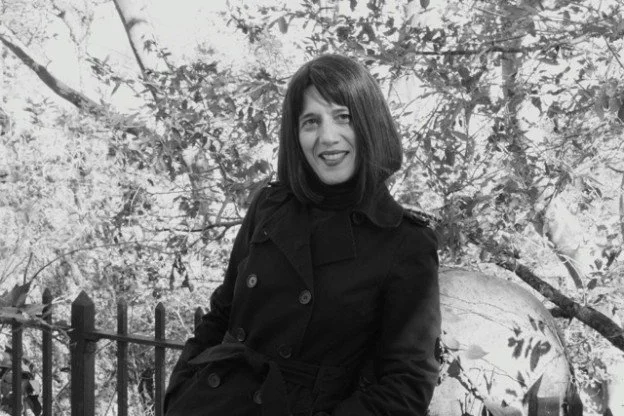Feminist Curious Steps Through History: Illumination in Dark Times
March 8, International Women’s Day, marks a global moment when feminists walk, chant, sing, and dance together in celebration of the transformative power of solidarity and collective action. In 2020, Istanbul is witnessing a new version of this celebration in the form of a “women’s run” organized by the sports section of the Istanbul Municipality, which recently changed hands into feminist-friendly leadership. Dark times call for creative politics: with feminist marches and other forms of political demonstrations in urban public space being suppressed by the government, women will run on a feminist path! And, much to our delight, the path of this women’s run has partially been inspired by the Curious Steps: Gender and Memory Walks of Istanbul.
Curious Steps in Kadıköy (photo courtesy of Murat Germen)
Feminists inspire each other! A group of us took our first steps toward designing Istanbul’s first feminist memory walk as part of our preparation for the Women Mobilizing Memory working group meeting in September 2014. Inspired by the feminist tour of Budapest (organized by the historian Andrea Petö of Central European University); the feminist walk of Bochum (hosted by Linda Unger of the feminist archive collective ausZeiten); and the informal memory walk that Soledad Falabella offered the Women Mobilizing Memory group in Santiago, Chile, in 2013, a group of us at SU Gender (Sabancı University Gender and Women’s Studies Center of Excellence) came together to imagine what it would mean to walk the streets of Istanbul with feminist curious steps. Another source of inspiration was the Militourism festival (2004–2006), organized by an antimilitarist group of conscientious objectors (including women objectors), drawing attention to the “militarist” sites of Istanbul, Ankara, and Izmir with creative “antimilitarist” performances. With decades of feminist scholarship on women’s history writing and the amazing (online) Women’s Museum Istanbul, which brought to light the complex intersectional layers of Istanbul’s gendered history, we felt well equipped to take our first steps in exploring the possibilities of feminist and queer re-rootings in our beloved city. At a time when we felt “uprooted,” with bombs exploding and the democratic space shrinking, exploring our feminist and queer roots as resources of inspiration and empowerment, and doing so through collective walking and storytelling, felt healing and transformative.
Ebrar Nefes telling the story of Afife Jale in Kadıköy (photo courtesy of Murat Germen)
In our contribution to the volume Women Mobilizing Memory, my coauthors, Bürge Abiral, Dilara Çalışkan, and Armanc Yıldız, and I argue that a feminist city walk offers the possibility to engage in “situated feminist storytelling” for mobilizing silenced memories, on the one hand, and making visible creative mobilizations of memory, on the other. Currently organized in three Istanbul neighborhoods, Curious Steps brings together diverse groups of people for collective walks through streets and sites that come to new life with hidden women’s and LGBTI+ stories, unmarked on site but researched and creatively told by young volunteers. As such, the walks enact what Cynthia Enloe calls “feminist curiosity” in urban space with an ever-growing and ever-changing repertoire of stories that merge public and intimate archives.
Selen Bayhan telling the story of Kınar Sıvacıyan (photo courtesy of Murat Germen)
After five years of walking in small groups, it is very exciting that we will soon be running with thousands of women to collectively witness some of these sites and stories of struggle along the path of the March 8 women’s run in the Asian neighborhood of Kadıköy. Right where the Kadıköy Women’s Run will start this March 8, we have our first Curious Steps stop in front of the State Conservatory, marking the outstanding legacy of artist Mermaid Eftalya (Atanasia Yeorgiadu, 1891–1939) who sang fifty-six of the one hundred recordings of the State Conservatory published by Columbia Records in 1927, without a single one mentioning her (Greek) name. On the other side of the State Conservatory, by the City Theater, we stop again to remember Kınar Sıvacıyan (1876–1950), one of the leading theater artists of the late-Ottoman and early-Republican period, who performed in numerous plays in the Darülbedayi (the precursor of the State Theaters) and other theaters across Istanbul. Despite her fame in the 1910s and 1920s, the Armenian actor Kınar Sıvacıyan has since been written out of all historical records, including theater history texts, while her Muslim contemporaries, such as Muhsin Ertuğrul and, later, Afife Jale, are remembered through theaters and awards named after them.
Curious Steps in Kadıköy, January 2016 (hearing Kınar Sıvacıyan’s story with a play on Afife Jale in the background)
Along the route of the Women’s Run another stop marks the Rexx Cinema, which used to house one of the oldest theaters in Kadıköy, the Apollon. This is where Afife Jale, the first Muslim woman actor to take public stage, performed her first plays. As we stop to talk about Afife Jale’s breaking all gender norms with her passion for theater and performance and facing serious challenges from her own family and the police, we also explore the intersectional layers of her struggle. In our narration, the story of Kınar Sıvacıyan’s helping Afife escape from the police, who regularly raided the theater upon receiving complaints that a Muslim woman was on stage, is a story of women’s solidarity in the background of ethnicized, patriarchal nationalism.
Another site of feminist and queer solidarity along the run is Yoğurtçu Park. Here, our Curious Steps stories focus on the significance of the park for feminist and LGBTI+ histories of activism, focusing particularly on the first march against domestic violence in 1987, after which the first women’s shelters were established, and the ongoing weekly Yoğurtçu Women’s Forum, a vibrant site of feminist debate and exchange since the Gezi protests of 2013.
Curious Steps at Yoğurtçu Park (photo courtesy of Murat Germen)
“Even in the darkest of times,” Hannah Arendt wrote, “we have the right to expect some illumination.” These are certainly dark times for Turkey, and the planet at large. Yet it is also a time in which we are witnessing new forms of creative, life-enhancing, transformative politics everywhere. From Black Lives Matter, which has shaken up the “normalcy” of white privilege and supremacy through an intersectional lens rooted in feminist and queer politics, to the global #metoo movement that is challenging the systematic workings of masculinist privilege and from the mass demonstrations of women in India cutting across religious, ethnic and caste lines to the viral Las Tesis movement against sexual violence and impunity initiated by women in Chile, we are facing a time of revolutionary reimaginings of gender and sexuality everywhere. The Kadıköy Women’s Run is only one among many March 8 activities planned in Istanbul this year, but a particularly inspiring one in the connections it is establishing with the city’s rich history of feminist activism. When feminist activism meets imaginative memory politics, new histories are made! And, as the Women Mobilizing Memory volume shows with many inspiring examples, they are being made everywhere.
As we walk, dance and run this March 8 in Istanbul, it’s heartening to know that millions across the globe will be coming together on International Women’s Day, and throughout Women’s History Month, illuminating these dark times with feminist activism and wisdom.
Annual Feminist Night March in Taksim, 2019.(photo courtesy of Çiğdem Üçüncü/NarPhotos)
Contributed by Ayşe Gül Altınay*, Women Mobilizing Memory working group
* Ayşe Gül Altınay is professor of anthropology at Sabancı University, former director of SU Gender (Sabancı University Gender and Women’s Studies Center of Excellence), and coeditor (with Maria Jose Contreras, Marianne Hirsch, Jean Howard, Banu Karaca, and Alisa Solomon) of Women Mobilizing Memory (Columbia University Press, 2019). The book, a transnational exploration of the intersection of feminism, history, and memory, shows how the recollection of violent histories can generate possibilities for progressive futures. It emerges from a multiyear feminist collaboration bringing together an interdisciplinary group of scholars, artists, and activists.
Note: This blog post was written before the killing of at least 36 Turkish soldiers in a massive attack near Idlib, Syria on February 28, and Turkey opening its borders soon after to allow refugees and migrants to pass, which has created a devastating humanitarian crisis at the borders and the Aegean Sea with Greek and Bulgarian authorities not allowing passage and suspending asylum applications. After the recent announcement from the Governorship of Istanbul that all political actions and demonstrations “against war” are banned until March 10th, it is not clear which March 8 activities will take place, and how they will be received by the security forces.
Women Mobilizing Memory in Harlem
In September 2014, vendors hawked mussels and shoppers slipped into H&M while Women Mobilizing Memory moved with a different purpose through Istanbul’s Istiklal Street. Our CSSD working group was embarking on a “gendered memory walk,” an activist-scholar intervention coined by our counterparts in Turkey. Ayşe Gül Altınay, anthropology professor and Director of SU Gender at Sabancı University, and several graduate fellows, including Bürge Abiral, Armanc Yildiz, and Dilara Çalışkan, organized the walk as part of the Curious Steps Program. Their goal was to highlight memory sites central to political movements towards feminist and queer liberation that risked being subsumed in history and the changing face of the city.
They led us through the bustling foot traffic on Istiklal and up steep medieval side streets to recognize landmarks we would have missed otherwise. Contemplating the ghosts behind these sites of social change, we beheld spaces like an independent bookstore known for selling radical literature and an LGBTQI organization persisting in human rights work despite being virtually illegal under President Recep Tayyip Erdoğan’s regime. In the essay titled “Curious Steps: Mobilizing Memory through Collective Walking and Storytelling in Istanbul” in our new anthology, Women Mobilizing Memory, our counterparts scrutinize their conception of this public humanities project in their own words.
As we prepared to bring these colleagues from Chile and Turkey to New York for the first time in 2015, the gendered memory walk in Istanbul stood out as one of the most inspiring events we had shared. The walk not only brought us together to bear witness to marginalized histories at risk for cultural amnesia; it also democratized academic knowledge as an activity that could be simultaneously interesting and freely available to the public sphere.
When we decided to stage our own walk in New York, we navigated some difficult questions. Whose history was most threatened by erasure in New York City? To what extent did we, as a group of highly educated, middle-class and predominantly white activist-scholars, have the right to represent that history? And which neighborhood was best positioned to address these questions?
Because our transnational peers had rooted their public interventions in critiques of the collective traumas that most deeply affected their nation’s histories, we aimed to do the same. Although the 9/11 terrorist attack is the trauma most readily associated with New York, we felt a more persistent and insidious history deserved a spotlight: the founding of America in the transatlantic slave trade, and the long history of racial animus that has instigated wide-ranging injustices from police brutality to gentrification in the present.
In this light, Harlem emerged as an important choice for many reasons— not the least of which was our own university’s ongoing colonization of one of the most famous Black neighborhoods in the U.S. Historically, Harlem has also been a contested zone for cross-cultural contact, influenced by an exceptionally wide range of competing desires, claims, and identities. Before gaining its international reputation as “Black Mecca,” Harlem was an entertainment epicenter where many performers were Black at venues that only served whites. An emphasis on entertainment also made the area a vibrant hub for queer nightlife in an era when homosexuality was strictly policed. The “Harlem Renaissance” started with the Renaissance Theater, also known as the Rennie, where Black patrons were allowed access for the first time; as time wore on, this theater hosted not only films and plays but also sports events and grassroots political meetings.
Collaboration in Harlem was historically intersectional, too. Women of color helped each other across social classes at Utopia Children’s House. White and Black book collectors desegregated libraries starting with the Schomburg Center for Research in Black Culture. Artists across the sexual identity spectrum, like Zora Neale Hurston and Langston Hughes, threw rent parties to keep each other solvent at community living spaces like 267 House. Thus the neighborhood was a vital center of intellectual, cultural and artistic creativity in New York City long before becoming stigmatized for criminal activity through the crack epidemic of the 1980s.
Our team of graduate students from Columbia University and New York University, including Henry Castillo, Andrea Crow, Alyssa Greene, Rüstem Ertuğ Altınay, Leticia Robles-Moreno, and myself, spearheaded the project. We strove to juxtapose well-known landmarks like the Apollo Theater alongside long-ago demolished businesses, like the row of queer-friendly bars that once occupied the block where a massive luxury condominium complex now stands. We also connected the stories of spaces on our route to broader national crises surrounding race relations, like the accelerating rise of white supremacy and white nationalism, the ongoing problem of police brutality disproportionately affecting Black men and transwomen of color, and the pervasiveness of gentrification pushing lifelong residents out of their homes.
We are thrilled to re-release the Harlem Memory Walk as an independent digital experience in anticipation of the debut of Women Mobilizing Memory. The walk is now available to anyone in the public sphere via PocketSights, a free mobile app on Apple and Android. Download the app, and search for the walk (if it doesn’t appear automatically) by searching for Columbia’s zipcode (10025 or 10027). For those who do not have smartphones, an updated version of the walk can also be accessed via Google Docs. We hope you will share the memory walk widely and thank you in advance for joining us on our journey.
Submitted by Nicole Marie, Gervasio, Ph.D.
August 30, 2019
Statement of Support for Ayse Gül Altinay from the Columbia University Center for the Study of Social Difference and Women Creating Change
Our colleague Ayse Gül Altinay, Professor of Anthropology and Director of the Gender and Women’s Studies Center at Sabanci University in Istanbul, Turkey, was sentenced to 25 months in prison earlier this week. She is one of over 2200 Academics for Peace who three years ago signed a statement “We will not be a party to this crime” appealing for an end to violent state-sponsored persecution of Kurdish citizens of Turkey. The investigation in Istanbul has covered only the first 1200 signatories so far, but it might be extended to the second 1000 as well. In this, her fourth, judicial hearing, Altinay was charged with “willingly and knowingly supporting a terrorist organization as a non-member.” The court's charge and thus the sentencing have no merit.
Ayse Gül Altinay has been a Faculty Fellow of Columbia’s Center for the Study of Social Difference since 2013. She is a co-organizer of the Working Group on “Women Mobilizing Memory” and a co-editor of the forthcoming Women Mobilizing Memory volume (Columbia University Press, 2019). Last September, she was also an invited speaker at the Center’s tenth anniversary conference “What We Can Do When There’s Nothing To be Done.” Her collaborative project “Curious Steps”— a gender-memory walk through Istanbul – spurred other such memory walks in additional sites including Harlem. Ayse Gül Altinay’s contributions to the Center’s work have been immeasurable: her feminist commitment to nonviolent protest and to transformative activism; her sharp insights into the workings of power and militarism and her determination to fight them; her fierce hopefulness combined with personal kindness, warmth and radiance have been an inspiration to all of us fortunate to be working with her.
In the spirit of collaboration and solidarity that Ayse Gül Altinay represents, it is important to point out that she is not alone in this struggle. Hers is one of a large number of cases receiving 25-month sentences that cannot be commuted. These cases, hers included, are in the process of being appealed. Some shorter sentences have been commuted, and many other colleagues are awaiting court dates over the next months. This is the time to speak out forcefully on all of their behalf and on behalf of freedom of expression and academic freedom.
On May 21st, 2019, Ayse Gül Altinay made the following statement to the court:
Every individual, every family living in this geography has suffered from past wars, migrations and experiences of violence. In terms of the cycle of violence that trauma studies alerts us to, we live in a challenging, vulnerable geography.
Yet, what we make of these past experiences of pain is up to us...
Are we going to turn our pain into more violence, hate, pain and injustice, or into steps that multiply life, beauty, love, peace and justice?
This is the main question that shapes my work and my life.
I firmly believe that we all have new steps we can take towards healing the traumas that have been transmitted from one generation to the other, and to break out of the cycles of violence that we are living through.
We, at CSSD and Columbia Global Freedom of Expression stand in solidarity and admiration for Ayse Gül Altinay and all of our academic colleagues who are being persecuted for their courage to speak out against violent aggression. The injustice of these sentences cannot be tolerated.
Marianne Hirsch Elected to American Academy of Arts and Sciences
Marianne Hirsch, co-director of CSSD's Women Mobilizing Memory project and Professor of English and Comparative Literature and of Women's, Gender, and Sexuality Studies at Columbia University, was elected a 2016 member of the American Academy of Arts and Sciences.
The American Academy serves the nation as a champion of scholarship, civil dialogue, and useful knowledge. As one of the country's oldest learned societies and independent policy research centers, the Academy convenes leaders from the academic, business, and government sectors to respond to the challenges facing the nation and the world.
Jean Howard Awarded Honorary Doctorate from Brown University
Photo courtesy of Nick Dentamaro/Brown University.
Jean Howard, George Delacorte Professor in the Humanities at Columbia University, co-director of CSSD's Women Mobilizing Memory working group, and former director of CSSD, was awarded an honorary doctorate by Brown University.
A teacher, scholar, and Shakespeare expert, Howard received her B.A. from Brown and served as a member of Brown's Board of Trustees from 1974 to 1981, leading the Committee on the Status of Women, and was chair of the Advisory Council on Diversity. She currently chairs the Associate Council of the Pembroke Center for Teaching and Research on Women, also at Brown.
CSSD Fellow Susan Meiselas Receives Honorary Doctorate from Columbia
Documentary photographer Susan Meiselas and member of CSSD working group Women Mobilizing Memory recently received an honorary Doctorate of Humane Letters from Columbia University.
At Columbia's dinner honoring the degree recipients, Meiselas said that the collaborative work of the group not only furthered interaction between the New York campus and the Columbia Global Centers in Istanbul and Santiago but also acted as a form of intervention.
Meiselas' important documentary work on human rights abuses in Chile and among Kurdish populations in Turkey inspired exhibits that Women Mobilizing Memory produced in Istanbul and New York, according to project co-director Marianne Hirsch.
Meiselas' attention to documenting individual stories as well as systemic injustice provides a powerful model for the group's use of the arts as a feminist means of mobilizing memories of violence in the interest of social justice, said Hirsch.
Working Group Members Edit Women's Studies Journal on Gender and Genocide
The European Journal of Women's Studies (EJWS) recently published a special issue on gender and genocide that was co-edited by Ayşe Gül Altınay, Professor of Sociology and Gender Studies, Sabanci University, and a member of CSSD's Women Mobilizing Memory working group. The issue was also edited by Andrea Petö, Professor of Gender Studies, Central European University, and included an interview with Marianne Hirsch, Women Mobilizing Memory project director, Director of the Institute for Research on Women, Gender, and Sexuality, and Professor of English and Comparative Literature at Columbia University.
Pictured: Ayşe Gül Altınay
The issue asks what role gender plays in the international legal and political frameworks created to prevent and punish genocidal acts and grapples with the nuances of memory, silence, gender, and genocide. Hirsch discusses feminist strategies to combat nationalism and militarism with scholarly analysis, art, and activism, among other issues.
Access the free introduction to the EJWS here.
Alisa Solomon Examines the Historic Theater of "Hamilton" in The Nation
Alisa Solomon, Women Mobilizing Memory member and associate professor of journalism at Columbia University, wrote in The Nation that "Hamilton" is not only a game changer because it brings rap to Broadway, but also because it integrates the contemporary musical style so seamlessly with the styles and structures of traditional musical theater.
While acknowledging rap as the latest popular music deserving to contribute to Broadway, the show also pays tribute to the older form by examining the themes of self definition and Americanness, both longstanding elements of American musical theater, according to Solomon.
The strong, multiracial casting of "Hamilton" also establishes that America’s history—and its future—belong to men and women of color as profoundly as to anyone else, she writes.
Read the full article here.
HEMI Publishes "Art, Migration, and Human Rights" Dossier
Notes on the August 2015 course on “Art, Migration, and Human Rights,” offered by the Hemispheric Institute of Performance and Politics, which partners with CSSD's Women Mobilizing Memory working group.
In August 2015, a group of 38 students, professors, researchers, photographers, filmmakers, artists, and activists from 13 different countries boarded a bus in San Cristóbal de las Casas for a weeklong trip across the southern Mexican state of Chiapas and the cities around it to study the urgent issue of migration. The trip was part of a three-week course on “Art, Migration, and Human Rights,” offered by the Hemispheric Institute of Performance and Politics, which partners with CSSD's Women Mobilizing Memory working group. Linked here is a dossier that is a collaborative project assembled in a week by the participants of that course—an exercise in collaborative pedagogy, the production of situated knowledge, and online authoring.
Women Mobilizing Memory Member on Democracy Now
Zeynep Gambetti, a member of the CSSD working group Women Mobilizing Memory and participant in the Collaboration and Co-Resistance conference and workshop, appeared on Democracy Now on September 11 to discuss the current series of attacks on Kurdish citizens and HDP party offices in Turkey.
Gambetti's segment begins at 25:00.
Gambetti, Associate Professor, Political Science & International Relations, Boğaziçi University, said that the Erdoğan government has "hijacked legitimate elections" with these reprisals against HDP expansion in the Turkish parliament and the political violence is pushing Turkey toward civil war. Women Mobilizing Memory staged a protest against the anti-Kurd violence at Columbia University the day before Gambetti's appearance.
Watch the discussion here.
WOMEN MOBILIZING MEMORY IV: A Week of Workshops, Exhibits, and Protest
For its fourth international meeting on "Collaboration and Co-Resistance," Women Mobilizing Memory gathered in New York in September. The group, consisting of scholars, artists and activists from Chile, Turkey and the United States, participated in a series of meetings and events that explored how the legacies of violent political histories might offer fodder for a more progressive and hopeful future. Previous meetings took place in Santiago, Montreal, and Istanbul.
At this multidimensional meeting, the forty participants not only commemorated the anniversary of the 1973 Chilean coup and the victims of the Pinochet dictatorship, they also issued a solidarity statement and protested Turkish violence against Kurdish minorities. One member provided commentary on the crisis for the nonprofit news program Democracy Now. Click to see photos and video.
The week began with a memory walk through Harlem, visiting both known and forgotten sites of art and protest that revealed the vibrant artistic and intellectual legacies of African American and some Anglo American institutions and individuals in the famous neighborhood.
A group art exhibit at the Leroy Neiman Gallery at Columbia opened the same afternoon and was followed by an artists’ roundtable. “Collaborative Archives: Connective Histories” included the work of artists based in New York, Istanbul, Berlin, and Santiago. The artworks demonstrated how intimate objects and stories both animate larger painful histories and resist their violent force. For the group, the artworks remained points of reference throughout the week, offering images through which to imagine and reimagine histories of slavery, war, genocide, and political repression. Click to see photos and video.
A second part of the exhibition, a curation of collectively produced posters, “CHILE: 40 Years of Struggle and Resistance,” opened at the Hemispheric Institute on Performance and Politics at New York University at the end of the week. The group also visited the September 11 Memorial Museum, analyzing and critiquing its official hegemonic strategies of memory. Click to see photos.
A public conference, “Women Mobilizing Memory: Collaboration and Co-resistance,” brought working group members together with scholars and activists from Columbia and New York in a series of comparative roundtables on women's strategies of political protest; on memory sites in Santiago, Istanbul and New York; and on the intimate archives of political violence. The discussions were enlivened by the interdisciplinary approach of the commentators and the focus on action, rather than mere commemoration. Click to see photos from all three panels and a Wishing Tree commemorative event, as well as video from the "Performances of Protest," "Mobilizing Memory Sites," and "Intimate Archives/Political Violence" roundtable discussions.
The bulk of the meeting was devoted to the scholarly work that group members had exchanged and read in advance. The constructive feedback members received on their individual papers and projects generated revisions and a future series of group publications on “Mobilizing Memory: Practicing Politics,” “Intimate Entanglements: Rethinking Kinship and Sexuality,” and “Little Disturbances: Arts and Politics.”
Total immersion in repeated, face-to-face meetings throughout the week enabled the group members to evolve and to grow in their understanding of the material. Across the meetings, they had the chance to consider both the challenges and the benefits of transnational interdisciplinary work, and to practice their commitments to feminist solidarity and progressive social change.
Contributed by Marianne Hirsch, Co-Director, Women Mobilizing Memory
PUBLISHED: Mobilizing Memory Curators Interviewed by "n.paradoxa"
Feminist art journal n.paradoxa recently published an interview with Ayşe Gül Altınay and Işın Önol, curators of the successful exhibition "Mobilizing Memory: Women Witnessing." The exhibition grew out of the CSSD working group Women Mobilizing Memory and has been produced at Depo in Istanbul and Kunsthalle Exnergasse in Vienna. The article is available for purchase here.
Katy Deepwell corresponded with both curators and discussed the dearth of both the gendered aspects of mass violence and the gendering of memory struggles in public debates. Altinay explained how the exhibit sought to address the role of witnessing as a practice of resistance. The curators wanted to give evidence of women using memories to organize, analyze, and cope. Altinay also notes that the artworks in the show particularly resist monumentality in favor of intimacy, pointing to an alternative mode of documenting violent pasts.
The exhibit reaches beyond the dichotomies of "women as victims vs. women as fighters" and "personal vs. public/political" and among other things uses the subtheme of "family," drawing connections between family photos and stories and national narratives of belonging and violence.
Altinay said the exhibit can be used to contextualize current conflicts with the Islamic State, Syria, and Iraq on the borders of Turkey. Pieces in the show can provide creative tools for struggling with wars and their memories in a gendered manner, claimed Altinay.
Önol commented on the different ways that the artworks show women using cameras to witness and record events related to war. They might record or revisit past events and thereby furnish alternative, subjective histories. The works might serve to collect existing information or they might provide proofs of suppressed facts.
Read the full article here.
ROUNDTABLE: Women Mobilizing Memory "Keywords"
Vulnerability. Reaction. Privilege. Heritage. Utopia. What associations do these “keywords” evoke? What concepts do they represent? How are these ideas used by scholars, or put into practice by activists? What kinds of work can we do with a keyword, what conversations can keywords unlock?
These were some of the questions asked at a recent roundtable discussion by Women Mobilizing Memory, a CSSD working group exploring issues of memory, witnessing, testimony, and trauma from a cross-cultural feminist perspective. For this project, students in graduate programs at Sabancı University (Istanbul), Columbia University, and New York University teamed up in pairs, selected their keywords, and finally presented the fruits of their collaboration in the form of a roundtable at the Columbia campus in New York.
Reflecting on the circumstances in which their discussion took place, Alyssa Greene (Columbia) and Armanc Yıldız (Sabancı University) considered the keyword privilege, acknowledging the immense institutional privilege that enabled the roundtable, and by extension their own critical examination of the word “privilege” itself. Their presentation urged a consideration of how privilege can easily be forgotten by those who benefit from it. The duo did not necessarily condemn privilege, but noted that it was an “unevenly distributed” resource, creating all kinds of differences between those it touches and those it does not. These differences can silence certain conversations, but they can also produce other kinds—like Greene and Yıldız’s reflections on how privilege made their conversation possible.
In a similar vein, the keyword reaction sparked thoughts on the role of the environment where groups like Women Mobilizing Memory do their work. Dilara Çalışkan (Sabancı) and Andrea Crow (Columbia) suggested that a “critical attention to historic and economic forces” is necessary. For example, how does the physical location of this roundtable at Columbia University, or the fact of it being conducted in English, shape the kind of work being done? “Reaction” can be an emotional response that tells us something about how we relate to the ideas, people, and circumstances that surround us. In a feminist perspective, reactions can be a revealing part of academic work.
The issue of translation, both literal and figurative, came up in the work of Nicole Gervasio (Columbia) and Bürge Abiral (Sabancı) on vulnerability. There is no precise translation of “vulnerability” in Turkish. The Turkish equivalent would mean something like “weakness” or “exposure to the possibility of being harmed.” Their co-written paper pointed out that vulnerability has become “not just a keyword, but a keystone” in the #blacklivesmatter movement: the practice of “die-ins” works as a deliberate public display of vulnerability. Vulnerability can be leveraged as a form of strength and protest, yet vulnerability can also be misappropriated by perpetrators of violence to justify their actions.
A common feature of the five keywords is that they have widely varying meanings that depend on context. Such was the case with utopia, analyzed by R. Ertug Altinay (NYU) and Pınar Ensari (Sabancı). The pair cautioned against an association of utopia with liberal ideals and progressive politics. Utopia has a dark side, too: utopia produces difference and exclusion—what is a utopian vision for the group envisioning it can easily become dystopian for other groups. With heritage as well, chosen by Henry Castillo (NYU) and Leticia Robles-Moreno (NYU), perspective matters immensely. The pair emphasized a distinction between official and unofficial forms of heritage. One is sanctioned by state and government while the other is constructed within the local environment of a specific community. Castillo provocatively asserted that heritage, in this latter sense, is the memory of individuals and communities—not an object or material possession. Yet it is embodied, too: Robles-Moreno continued the discussion by suggesting that the female body can transmit heritage biologically and symbolically through generation.
Contributed by Grace Delmolino, PhD Candidate in Italian/ICLS and 2014-15 IRWGS Graduate Fellow
ART EXHIBIT: "Die Presse" Reviews "Mobilizing Memory" in Vienna
Vienna's "Die Presse" reviewed the "Mobilizing Memory" exhibit that was created by the CSSD working group Women Mobilizing Memory and launched in Istanbul in 2014.
“‘Mobilizing Memory:’ Armenian Women Who Don’t Forget”
Anne-Catherine Simon (March 31, 2015, Die Presse)
“Mobilizing Memory” shows how women use memory to practice resistance to oppression: a politically charged show in Vienna.
They’re called Saturday Mothers. Every Saturday for twenty years, women have been standing on the street, in Galatasaray or in another Turkish square. They hold up pictures of their sons. Or their husbands. They are officially counted as missing; in reality, they were murdered for political reasons.
“The mothers’ tenacity in witnessing to this is the strongest form of resistance,” says Işın Önol. The artist comes from Istanbul and has lived in Vienna for five years. Here she has organized a powerful exhibition about forms of female, and sometimes publically celebrated, memory. “Mobilizing Memory” will be on display through Friday and could hardly leave the viewer cold. The piece by Argentinian-born Silvina Der-Meguerditchian was developed specifically for the Vienna show and especially is noteworthy, just weeks before the memorial day marking the deportation of Armenian intellectuals from Istanbul 100 years ago, the beginning of the murder of hundreds of thousands of Armenians. Armenian descendants of survivors living in Vienna knitted together their old family photos—literally, with wool—into a kind of Anatolian carpet. On the white screen that comprises the back side of the piece is a video showing the women in the midst of this collaborative memory work. The photos show families together before the camera, who were never together again after the genocide. The family of the artist also shared this fate; Silvina Der-Meguerditchian is the granddaughter of displaced Armenians.
Memory Work in Vienna
The knitwork shows one of the unique aspects of this exhibition – it not only depicts memory, but also generated memory in its workshops. How does it affect a people with no national memory culture, like the Kurds? On akakurdistan.com, Susan Meiselas has tried for years to fill in these gaps. For “Mobilizing Memory,” she also held a workshop with women from Iran, Iraq, Syria, and Turkey. “In Vienna we continued collecting,” says Önol. Denise Sözen in turn interviewed residents of the Armenian neighborhood in Los Angeles.
The exhibit was already on display in a similar form in Istanbul, the idea of which came from a feminist research project by American and Turkish academics. “I like using the image of the unbroken camera,” says curator Işın Önol. “When political violence takes place in public spaces in Turkey, the story usually is, ‘unfortunately, the security camera was broken when it happened.’ For me, the witnesses are unbroken cameras.”
“Mobilizing Memory.” On display until Friday, April 3, in the Kunsthalle Exnergasse, Währingerstraße 59, Vienna 1090.
Translation: Alyssa Greene
WOMEN MOBILIZING MEMORY: Effective Activism for Human Rights
CSSD’s Women Mobilizing Memory working group met in late February to discuss, in a comparative perspective, the links between memory and activism and between memory practices and movements promoting human rights.
Examining current protest movements in the wake of the Arab Spring and Occupy Wall Street, members engaged in sustained debate about whether, and in what circumstances, such protests are useful in mobilizing people for sustained activist efforts at social transformation.
Among the aesthetic tools that might mobilize memory for progressive social change are the digital arts and photography, performance, and media, each of which can have strong ties to human rights law and academic examinations of inequality and the systematic erasure of memory.
The group suggested that while street protest was perhaps the most visible venue of mobilization, it was often overly romanticized and could not be sustained indefinitely. Still, the action of individuals coming together to claim a civil space has proved to be a useful tool for fomenting social and political transformation, as we saw in the frequent civil rights and peace protests of the 1960’s and the massive anti-war demonstrations at the beginning of this century.
One student activist spoke of the current difficulties of using public space on the Columbia campus for unionizing, where the rules of institutional decorum did not permit such activity, deeming it “confrontational.” Breaking the rules, however, is indeed what gets social movements noticed.
The group agreed that holding a public space indefinitely was not necessary to make a protest effective, so long as the innovative ideas being discussed continued to circulate after the physical protest ends. A street protest might ultimately be ephemeral, but as the 2011 Occupy Wall Street movement demonstrated, one action could lead to a series of related actions. As with Occupy, the communication of a sustained message (“99%”) can spark social connections to recycle the message and use it for new forms of protest.
Istanbul’s Saturday Mothers of Galatasaray Square are an example of sustained, networked protest with earlier roots. These activists have appeared since 1995 bearing photos of their children who were most likely murdered by government security forces. Their work was in turn inspired by the Mothers of the Plaza de Mayo in Buenos Aires, women who since 1977 have mourned the disappearance of 30,000 individuals under Argentina’s dictatorship. Similar occurrences also take place in Mexico and Rwanda.
Similarly, many in the group claimed that the power of social media lies in the circulation of key phrases that act as an engine, generating an expanding desire for and a manifestation of change in the real world. Protesting the police murders of Michael Brown in Ferguson, Missouri and Eric Garner in Staten Island, New York this past year, activists throughout the country made phrases like #Ferguson, #icantbreathe, and #BlackLivesMatter go viral, leading to clashes with the police, freeway shutdowns, and other interventions. Risking arrest or violence was key in getting these events noticed.
While one member said that activism seems to have flatlined since 2011, since it lacked uniform goals and organization, another claimed, that on the contrary, many more students are now interested in course work around social change. It is important to remember that only a few years have passed since the events of the Arab Spring and Occupy, and that systemic social change requires much more time.
Contributed by Terry Roethlein, Communications Manager, Center for the Study of Social Difference
Image: Brittany Ferrell, Ashley Yates, and Alexis Templeton, Co-Founders of Millennial Activists United, an organization focused on outreach, policy campaign, civic engagement and direct action, in Ferguson, Missouri.
Banu Karaca in The New York Times
Banu Karaca, a member of CSSD working group Women Mobilizing Memory, was quoted in a recent New York Times article about creeping censorship amid the current flourishing of the arts in Turkey.
Karaca is a founder of Siyah Bant, an organization that monitors arts censorship in Turkey.
Read the New York Times article here.
WOMEN MOBILIZING MEMORY: Patricia Ariza on Culture as a "form of resistance"
TRANSFORMING TRAUMA WITH THEATRE
“Culture is a form of resistance,” asserted Colombian playwright, director, producer, and actor Patricia Ariza as she met with twelve members of the Center for the Study of Social Difference's Women Mobilizing Memory working group at the Hemispheric Institute in New York City.
Ariza was recently in town to accept the 2014 Gilder/Coigney International Theatre Award from the League of Professional Theatre Women but she took time to discuss with the group her near fifty years of work employing theatre to promote social justice, particularly as it applies to Colombian politics, political violence, and women. Ariza is co-founder of the highly influential Teatro La Candelaria, Colombia’s first independent, experimental theater, and for the past 25 years has focused primarily on women and social justice, empowering traumatized citizens to express through public performance their experiences during the massive violent conflicts that have rocked Colombia for decades. These performances help transform pain into something socially constructive, she said.
Ariza showed a video of an encuentro, or action, she orchestrated in 2009 at Plaza de Bolívar in Bogotá where 300 women, mostly survivors of political violence and family members of deceased/disappeared victims, grieved and memorialized for a whole day the systematic assassinations of political leaders throughout the country. Civilian demonstrators joined by theatrical performers chanted “Dónde están?” (“Where are they?) as they carried photos of their missing and murdered relatives. Ritualistic choreography accompanied by fandango drummers and piano culminated in one dancer climbing atop the statue of patriarch Simon Bolívar. Participants stepped through life-sized silhouettes of the bodies of the victims as a song instructed the mourners, “If you want to sing, sing/If you want to cry, cry.” Many did just that.
A DIFFERENT WAY OF INHABITING PUBLIC SPACES
Speaking through a translator, Ariza said that originally she did not intend to devote the last quarter-century to doing memory work with victims groups. “At first, I thought it was an act of generosity,” she said, “but then little by little it came to me that they provide a special, deep knowledge—a different way of doing political actions…and inhabiting public spaces.”
Ariza told the group that only recently have women been permitted to politically inhabit public spaces like town squares, which have historically been reserved for male-oriented political and military purposes.
“Art can help a lot,” said Ariza, who said cultural actions and celebrations are important sites of resistance against political oppression and violence. “It can get people to stop thinking war is the solution. You can’t do that through laws—only through culture,” she said.
With a slightly bowed head and limited eye contact, Ariza discussed another action that memorialized the government-approved murders of approximately 4,000 members of the left-wing U.P. (Patriotic Union) party in the 1980’s. In the action, 1,050 U.P. survivors stood at 1,000 candlelit tables in Plaza de Bolívar wearing the clothes of the deceased and placing their possessions on the tables. She said people came from all over Bogotá to see the performance, which was repeated for three years.
A spirited discussion ensued after Melody Brooks, co-chair of the Gilder/Coigney Award, inquired about the U.S. “Plan Colombia” that funds military missions against drug cartels and left-wing insurgents. Ariza said that the Colombian military has provided ersatz results by perpetrating approximately 4,000 murders of “false positives”—innocent citizens falsely characterized as drug traffickers or insurgents.
Ariza said that in an effort to aid Colombia’s compromised peace process, she hoped to plan an international peace summit of women in theatre in New York in April 2015.
Contributed by Terry Roethlein, Communications Manager, Center for the Study of Social Difference
Image of Patricia Ariza, center, at the Hemispheric Institute Encuentro in Bogotá, Colombia, 2009, by Cristhian Ávila.
Nancy Kricorian Published in Guernica Magazine Daily
Nancy Kricorian's essay "Pilgrimage as/or Resistance," which was originally presented earlier this year at the Women Mobilizing Memory workshop at Depo in Istanbul, Turkey, has been published by Guernica.
VIDEO: "Gender, Memory, Activism"
Women Mobilizing Memory workshop: "'Coming to Terms' with Gendered Memories of Genocide, War, and Political Repression," featuring Marita Sturken, Marianne Hirsch, Nükhet Sirman, Meltem Ahıska, and Nancy Kricorian. Istanbul, Turkey, September 2014.
VIDEO: "Art, Performance, and Memory"
Women Mobilizing Memory workshop: “‘Coming to Terms’ with Gendered Memories of Genocide, War, and Political Repression,” featuring Andreas Huyssen, Alissa Solomon, Carol Becker, Diana Taylor, and Maria José Contreras. Istanbul, Turkey, September 2014.


